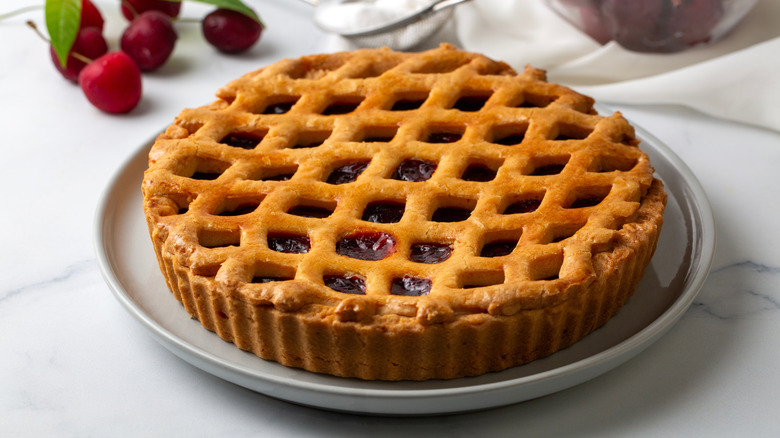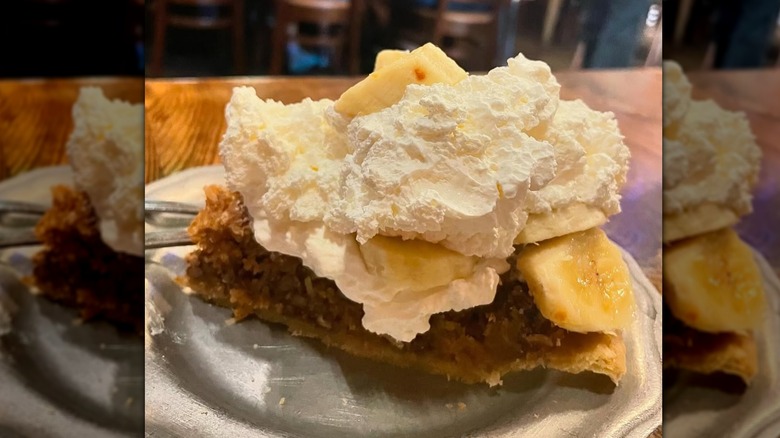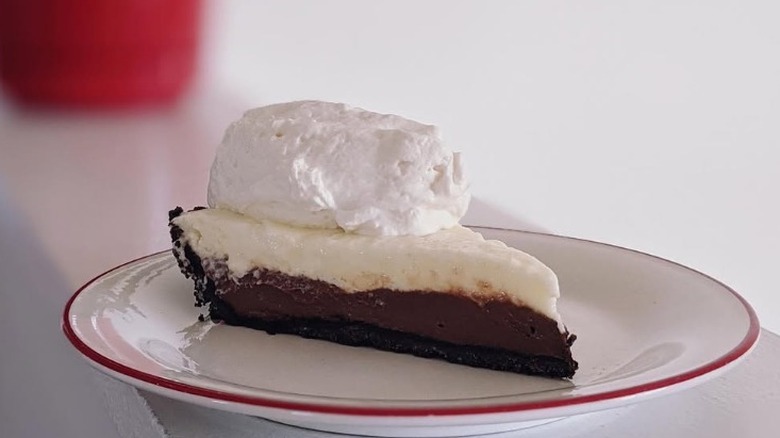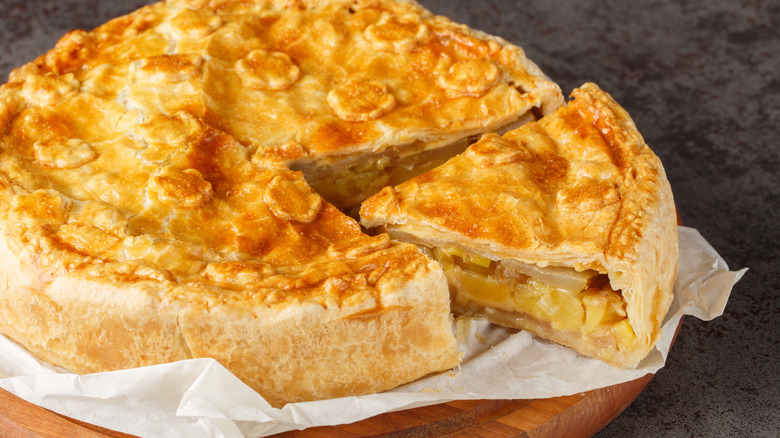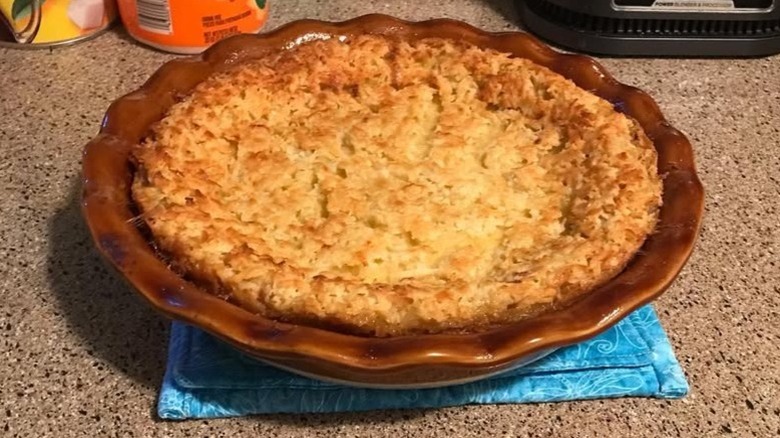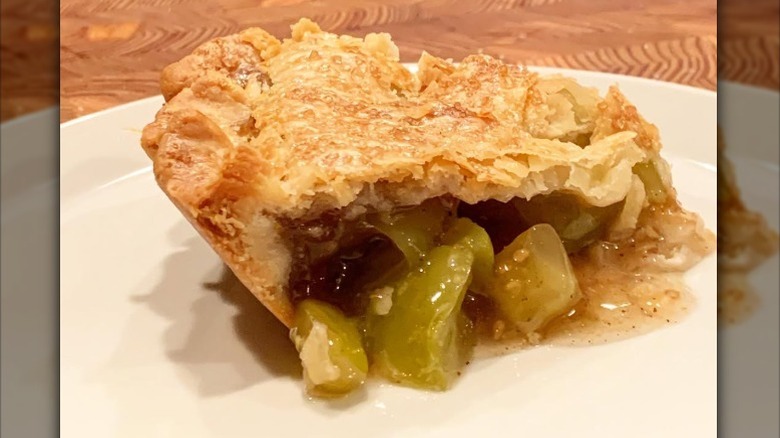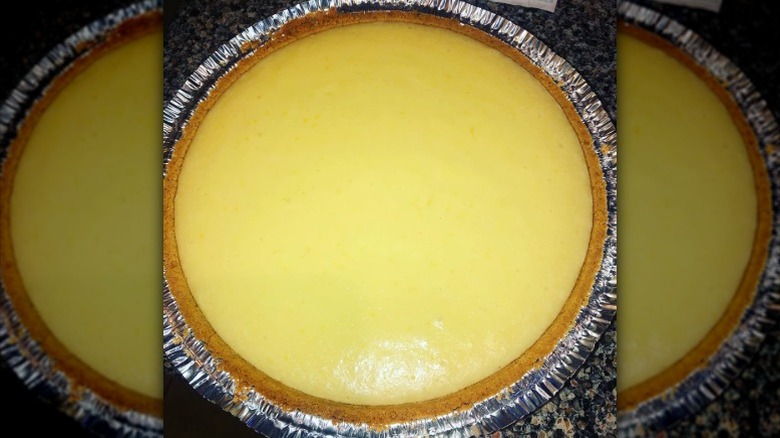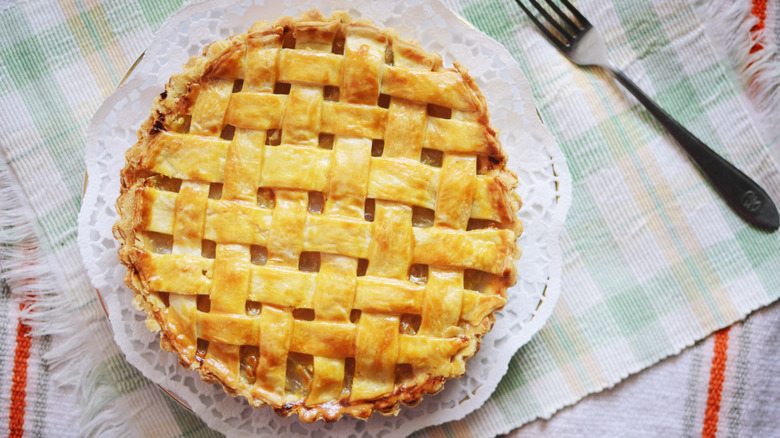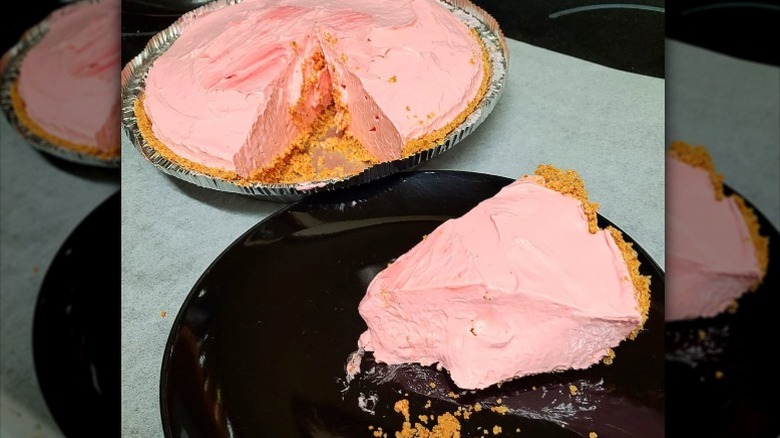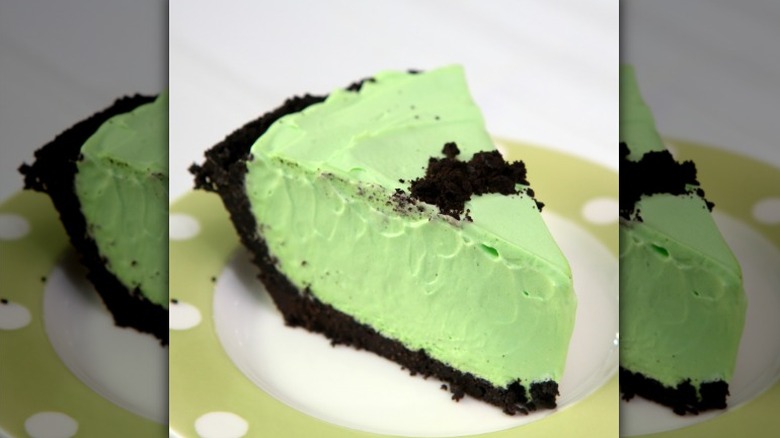10 Classic Pies That Have Nearly Vanished
The humble pie might be as quintessentially American as desserts could get. It's safe to say that almost everyone in the United States has fond memories of eating pies since childhood. But did you know that this American staple wasn't created in the country? Instead, it's believed that Ancient Romans (with Greek inspiration) are among those to have the earliest written pie recipes. The idea of pies soon made its way to England where the dish was really embraced. When English immigrants later arrived in America, they brought these delicious treats along, and the rest is history!
The United States has so many types of pies today, from an easy apple pie that's loved across the country, to regional favorites like Southern-style sweet potato pie. Interestingly, what's now seen as an indulgent dessert was once preferred by people in the country because it was a great way to use available ingredients economically. Of course, this led to the creation of plenty of pie flavors. Later, the introduction of iceboxes and convenience food gave people the means to experiment further with pie fillings. While some of these pies have managed to remain beloved classics in American kitchens to this day, many of them have nearly vanished. If you'd like to take a trip down memory lane and see what these pies were like and what eventually caused them to fade out of the limelight, you're in for a treat with this list.
Sawdust pie
Though the term sawdust might make this pie sound unappealing, it was anything but. In fact, sawdust pie was made with such a lovely combination of ingredients that it would genuinely make you wonder why it isn't as prevalent anymore. The moniker came from the way its filling looked, because children mentioned that it resembled baked sawdust. The earliest recipe for sawdust pie appeared in Bon Appétit magazine in 1983, making it only a few decades old today.
Sawdust pie had a filling made with sugar, coconut flakes, pecans, graham cracker crumbs, and egg whites. All one had to do was mix these ingredients together until well combined, pour them into a lined pie crust, and bake until set. But that's definitely not all! Once the pie cooled, it was topped with a hefty amount of whipped cream and sliced bananas.
This pie was made for the first time at Patti's restaurant situated in Grand Rivers, Kentucky supposedly in the late '70s. In fact, the recipe was published in Bon Appétit magazine because a woman wrote the editor a letter stating she enjoyed sawdust pie for the first time at that very restaurant. After it was featured in the magazine, its popularity grew. But unfortunately, this pie isn't as common in most American kitchens today. If you'd still like a slice, you can make it at home given how easy the recipe is, or get it at Patti's 1880's Settlement, Kentucky.
Black bottom pie
If you like classic chocolate pies, you're bound to love an old-school black bottom pie. Recipes for this decadent pie began appearing around the beginning of the 20th century. The base was mostly made of crushed ginger cookies, though sometimes graham crackers were also used. This pie's filling was a luscious mixture of milk, cornstarch, sugar, vanilla, and gelatin, along with the star ingredient: chocolate. Plenty of recipes used cocoa powder instead, as it could easily be swapped in when out of baking chocolate. Once the chocolate filling set, a creamy topping made with gelatin and whipped cream was spread over the pie. Usually, the topping was also flavored with either vanilla or rum. Some versions were slightly more complicated than this one, but this was the most standard way to make a black bottom pie.
Though some recipes came around a bit earlier, this pie actually rose to fame in the late '30s. It remained popular over the following decade, as this was also the time people either already had iceboxes or started investing in refrigerators — perfect for this no-bake dessert. As for its origin, some people believe it to be from the Southern United States, which isn't surprising considering how pervasive pies are there. However, according to research most claims remain that the pie was actually created in Southern California — Los Angeles to be specific. Black bottom pie soon became a beloved dessert across the country. But over the years it did lose its touch, and now barely anyone knows about this vintage classic.
Onion pie
When you think of an onion pie, you might picture a pie packed with savory ingredients. But believe it or not, the onions in this pie were often paired with apples. As odd as that sounds, it's likely that the pie tasted okay, which led to it becoming popular in the 18th century. Moreover, it needed only a handful of budget-friendly ingredients, making it an ideal meal to feed a family when rations were tight — something that many people were looking for back in the day.
A recipe for onion pie was also featured in one of the first editions of "Primitive Cookery." This cookbook was, in fact, meant for home cooks who wanted to prepare cost-effective meals. A recipe also appeared in a cookbook in 1747 called "The Art of Cookery Made Plain and Easy."
So you're probably wondering what else was in this pie and how it was made. A filling made with onions, apples, and potatoes that was often flavored with spices like nutmeg, pepper, and mace was packed in a homemade pie crust and baked. People made onion pies after the 18th century as well, but the newer variation was completely different as it sidelined the potatoes and apples and used cheese and cream instead. The older version eventually faded into obscurity. But if it still sounds intriguing, you could try making it yourself. You also don't have to worry about tearing up when slicing all those onions, as there are plenty of ways to chop onions and not cry.
Impossible pie
It's believed that impossible pie was created in one of the Southern states. That said, if you have ever browsed through old-school Betty Crocker cookbooks, you might be wondering which impossible pie we are talking about, since they had an entire series of recipes with that name. Well, there was originally only one impossible pie, and the idea behind it was that it didn't require a separate pie crust. Instead, all the ingredients were combined together and added into a tin to form a pie where the filling and the crust were essentially the same.
General Mills was inspired by the dish and came up with a range of Impossible pie recipes which suggested using Bisquick mix. However, most of them weren't even close to the original impossible pie, except the impossible coconut pie, which was unsurprisingly also one of the first recipes published in the Betty Crocker Impossible series. The original impossible pie was made with ingredients like eggs, melted butter, flour, milk, vanilla, sugar, and coconut flakes, and as per records, the first recipe was released in 1968. Everything was blended together and poured into pie tins, then baked. Since the pie was packed with coconut, its roots were linked to the Southern states, as the ingredient was commonly added to pies there. Some variations of the original recipe came around in the '70s, including one that swapped flour for buttermilk biscuit mix. But the pie's popularity eventually declined.
Green tomato pie
While there are plenty of tasty recipes you can make with tomatoes, using them in a pie wouldn't instantly come to mind. But believe it or not, tomato pies made with red tomatoes are still often enjoyed and no, they aren't the same as pizza. Sadly though, green tomato pie from yesteryear has indeed vanished. Interestingly, it was a sweet pie that closely resembled apple pie. This was because it was quite common to use green tomatoes in place of apples in pies when the latter wasn't readily available a couple of centuries ago .
Green tomato pie was mentioned in The Washington Post all the way back in 1901. This dessert was quite the rage around the same time, especially in the South. It was made the same way apple pies are, of course, with a homemade pie crust as the base. The filling was prepared by mixing chopped or sliced green tomatoes with sugar, cinnamon, and flour. Raisins were also often added to the mix. The finishing touch was a crust on top, after which the pie was baked. The idea probably sounds weird but the pie turned out pretty delicious, thanks to the similar texture and taste of apples and green tomatoes. Hence, it's definitely worth giving green tomato pie a shot when you're looking to experiment with a classic apple pie recipe.
Lemon icebox pie
This retro pie was partially named after the appliance it was stored in, which was essentially an early version of the modern refrigerator — the humble icebox. Though there were plenty of icebox pie flavors back in the day, the one that managed to catch on with people most was the lemon icebox pie. Folks in the Southern United States loved making this pie on hot days because it was a no-bake dessert and was served cold.
Lemon icebox pie consisted of a crust made either with vanilla wafers or graham crackers. The filling was made with lemon juice, egg yolks, condensed milk, and sugar, but some versions also added gelatin to help it set better. It was usually served as-is, but some people also preferred topping it with meringue. As you may have figured, it could be prepared in very little time.
Even though iceboxes were common in the mid 1800s, one of the first recipes for lemon icebox pies supposedly appeared in the 1930s. Surprisingly, iceboxes were also seeing a major decline in popularity around the same time, as refrigerators had started taking over. But that didn't really stop anyone from making a classic lemon icebox pie and cooling it in the refrigerator. However, this pie eventually lost its charm even after people started refrigerating them. It now remains a beloved nostalgic dessert for many. For anyone who wants to try, luckily, it can easily be replicated at home.
Transparent pie
A classic from Kentucky, transparent pie is often confused with the southern chess pie, but they aren't the same even though they have a similar appearance. This pie was created by people living around Northern Kentucky. It could be put together easily, and also had a subtle flavor.
Those who created it essentially mixed together whatever ingredients were available in their kitchens. So, the filling was made with cream, butter, flour, eggs, sugar, and a dash of vanilla. Just like most classic pies, the simple filling was then poured into a pie shell and baked.
Transparent pie originated in the 1800s, with references showing up in local newspapers in the state around the 1890s. However, this pie really made a mark across Kentucky after it became available at Magee's Bakery situated in Maysville. The bakery actually began serving the pie a few decades after it was created, in the 1930s. Unsurprisingly, transparent pie is still somewhat prevalent in some parts of Kentucky. But besides that, its appeal is mostly lost. It's still worth trying this recipe considering its simple flavors, and even more so if you're a big fan of George Clooney, as he is a major admirer of this pie thanks to his Kentucky roots. Since it has a mild flavor base, you can also experiment and switch some of the ingredients from the traditional recipe to make it your own.
Pineapple pie
There are plenty of ways pineapple is eaten around the world, but adding it to desserts was possibly the favorite way to enjoy it for most Americans. Take this vintage pineapple pie, for instance, which was quite popular in the 1900s and various companies printed out recipe advertisements for it. Though it's difficult to pinpoint when and where this pie originated, it can be assumed that it was around the same time canned pineapples hit the market.
In fact, three recipes appeared in an advertisement for canned pineapple by Hawaiian Pineapple Canners supposedly in 1922, calling it "The Great American Dessert." One recipe suggested topping the pineapple pie with meringue, another involved covering the filling with a pie crust, and the last one was pretty fancy, as it had various layers of pie crust, pineapple filling, and whipped cream. Almost two decades later in 1938, Good Housekeeping also printed a recipe for this pie and it was quite simple as it only consisted of a pastry crust, pineapple filling, and a homemade meringue.
Later in 1950, Pillsbury released a recipe for pineapple pie in an advertisement to market their pie crust mix. This was one of those quintessential pie recipes, with a crust at the base, a hearty pineapple filling, and lattice work with the remaining pie crust on top. Regardless of all these advertisements over those few decades, the humble pineapple pie's popularity eventually did decline, probably due to changing preferences.
Kool-Aid pie
Considering how much people love the refreshing drink itself, it's not a shocker that someone decided to turn it into a pie at some point, though it isn't known who created the recipe. That said, one of the first documented instances of Kool-Aid pie in print was in 1974. The pie tasted exactly like the beverage, sweet and refreshing, with the filling nestled over a perfectly crunchy crust.
Kool-Aid pie was great for hot days, not only because of its light flavor, but also for being a dessert that required no cooking or baking. The base was simply made by lining a pie tin with crushed graham crackers. Its filling required mixing Kool-Aid, sweetened condensed milk, and whipped cream/Cool Whip together until it was light and airy. After its prominence in the late 20th century, this pie saw a surge in popularity once again starting in 2009. The searches continued to grow slowly, with occasional spikes until almost the end of 2022, especially in Mississippi. But after that peak, interests steadily declined, and the pie lost its prevalence across the country once again.
The best part about this vintage pie, and also a solid reason why it deserves a revival today, is that it can be made with any flavor of Kool-Aid. So, if you're a fan of the drink, there's no reason not to give this forgotten pie a shot on a summer day.
Grasshopper pie
We bet you're wondering what exactly grasshopper pie is and how it got such a strange name. Was it made with real grasshoppers? Luckily, no. Grasshopper pie was actually named after a classic cocktail called grasshopper and not the insect. This cocktail is made with white crème de cacao and crème de menthe — the liqueur that gave it a striking green color similar to a grasshopper, hence the moniker.
Grasshopper pie unsurprisingly had the same flavor combination as the cocktail — which had the perfect balance of mint and chocolate, making it taste refreshing and decadent at the same time. Its filling was made with both the liqueurs used in the cocktail, milk, cream, and marshmallows, though some recipes switched the liqueurs with extracts. It was made by heating the milk, melting the marshmallows in it, adding in the liqueurs, and folding in whipped cream. The crust featured crushed chocolate wafer cookies. Once the pie had set, it was garnished with even more dark chocolate to make it taste extra rich.
It's believed that grasshopper pie was actually invented by the wife of the person who created the grasshopper cocktail. The original recipe for the pie appeared in the '60s and it was a massive hit throughout the decade. It managed to stay prevalent even in the '70s, after which it faded out of the limelight. Nevertheless, those who like mint and chocolate together should give this no-bake pie a go, as it's very likely that they'd enjoy it.
